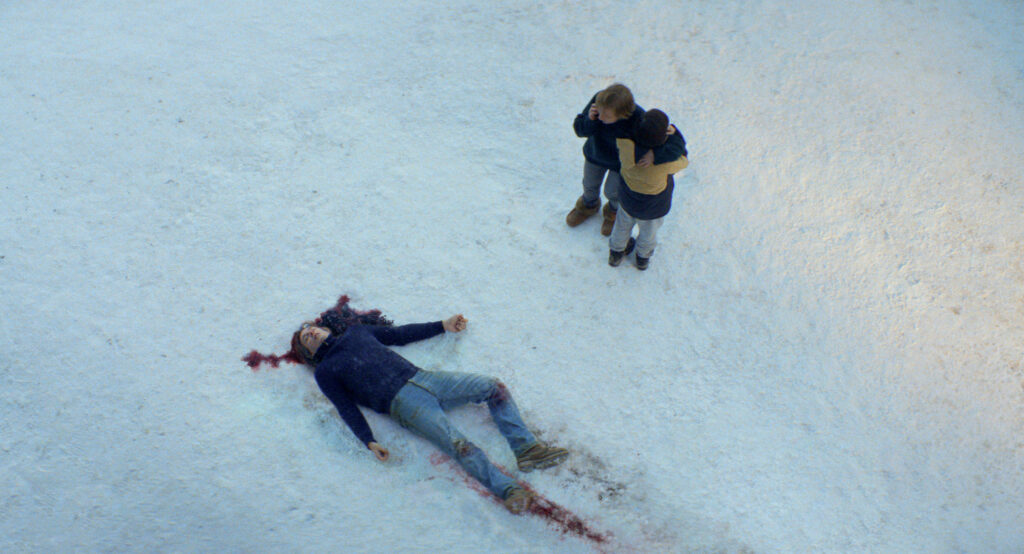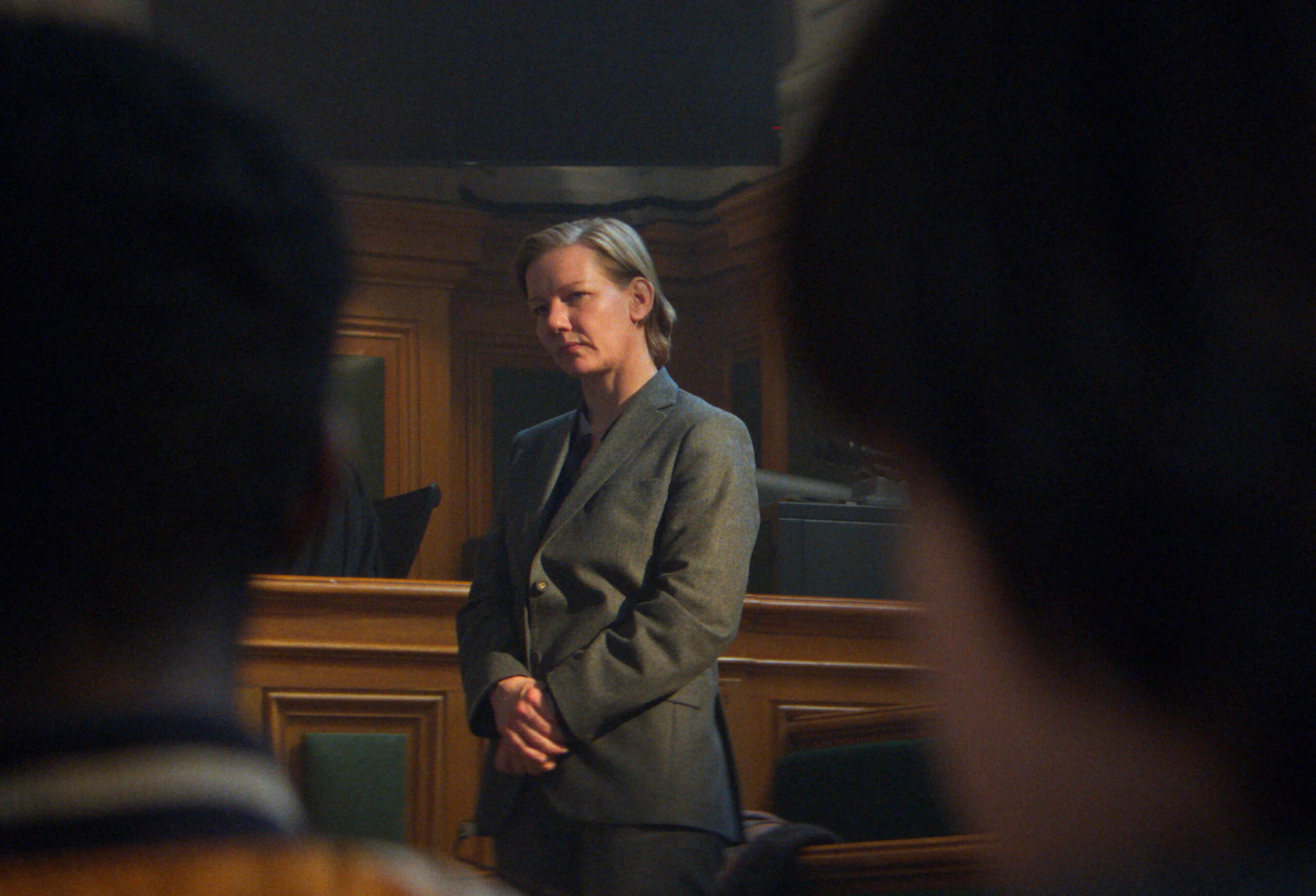At 150 minutes long, Justine Triet’s Anatomy of a Fall takes place largely within the confines of a courtroom. However, the first few minutes of the film provide a brief yet impactful glimpse into the lives of Sandra (Sandra Hüller) and her husband, Samuel (Samuel Theis), at home. Living an isolated life in a French mountain chalet with their son, Daniel (Milo Machado-Graner), and dog, Snoop, Sandra is a writer in the middle of an interview. Mere moments into the conversation, Samuel begins blasting an incessant loop of the P.I.M.P instrumental at increasing volume two floors above. Completely unseen, yet with a presence fully felt, what begins as a slightly comical moment devolves into a bleak look at a woman being forced into a corner of submission and isolation. While Sandra willfully maintains her composure, eventually the music drowns out all else and she is forced to rush the interviewer out the door. In a manner both subtle and commanding, Triet is able to lure the viewer directly into the framing device on which the rest of her film will brilliantly rely. The first time we see Daniel in person, he is lying in a pool of his own blood after a three-story fall from the roof. We are no longer passive viewers of the film but, rather, active participants. Triet has selected us for the jury, and we have just heard the prosecution’s argument.
Provided with very little to work off of, Triet, and in turn the prosecution, immediately set the audience up with a very basic, yet concrete, idea of this couple’s relationship. The opening credits make way for Sandra meeting with an old friend, Vincent (Swann Arlaud), a lawyer. After looking around the house, he assesses the situation not for what it is or what it might be, but rather, what it will look like. It’s in this scene that Triet begins her own examination towards the court of public opinion, and how preconceived notions lead to the choices we make. As Sandra details the events leading up to discovering her husband’s body, she breaks away from her own thoughts to make a simple plea to a friend: She sticks to her truth that she did not kill her husband. Vincent, in a matter-of-fact manner, points out, “A trial is not about the truth.” Rather, it is about how the jurors in that courtroom will perceive the defendant, or in this case, how they will perceive a wife who is the only key suspect of a suspected murder trial. Through brilliantly understated stylistic choices, Triet doesn’t toy with the viewer, but instead frames her argument from both the director’s chair and her script. It feels as if she is holding her own court concurrently alongside Sandra’s trial.

Take, for example, a moment where Sandra details excerpts from her relationship with Samuel. The camera is hyper-fixated solely on her lips as she testifies. Without hesitation, we, as both audience members and jurors, scrutinize the most minute expressions. Furthermore, we can do nothing else aside from take what we have just analyzed, and frame it within our own belief of what occurred. In a conversation regarding the film, Triet noted, “The courtroom is essentially where our history no longer belongs to us, where it’s judged by others who have to piece it together.” On one hand, Triet feels critical of this notion, mainly due to how she frames the prosecutor’s arguments and performance. Still, she acknowledges the blatant truth of this, and any, courtroom: somebody there is being judged, and regardless of an age-old adage, the burden of proving one’s innocence exists.
The Prosecutor (Antoine Reinartz) goes unnamed in this film. Credited as merely his job title, it’s a performance that rigidly sticks to what the job entails. Combing over every aspect of Sandra’s life, he rather unfairly presents archaic ways of thinking to best serve his arguments. Triet aptly describes his character as somebody who “portrays civilized violence.” His job is to speak for the deceased; to convince us, and the jurors, that Sandra must have murdered her husband. He repeatedly frames Sandra in a negative light through a myriad of aspects of her life: her sexuality, her career, her motherhood. Focusing on these three aspects, The Prosecutor repeatedly belittles Sandra through the lens of a very misogynistic, outdated understanding of womanhood. This is all done in the name of justice. In the eyes of his argument, surely Sandra must have snapped due to her breaking the “conventional gender norms” of being a woman. He inappropriately points out her bisexuality, and claims the interviewer from the beginning of the film was present solely to sexually frustrate Samuel. He uses Sandra’s books to posit she is an author confessing her sins through her fiction. Time and time again, while the facts of the case are blurred enough to understand the questionable nature of Samuel’s death, The Prosecutor places his focus on deeply conservative modes of thinking to justify his claims. And rather than have a bombastic back-and-forth between prosecutor and defendant, Anatomy of a Fall takes a far more nuanced, authentic approach to this court case.
As Sandra’s defense lawyer, Vincent is far more reserved. Rather than use flash to sway the jury, his approach is one of calmly highlighting the inconsistencies of The Prosecutor’s thinking. Vincent, from the very outset, is clearly nervous about the idea of a courtroom opinion being far different from public opinion, let alone the genuine truth. He is blatantly aware that, more likely than not, he will have the more difficult position when speaking to the jury. “And of course, you’re his wife”, he says early on when telling Sandra the motives that will be brought up in court. Sandra is not merely on trial for the suspicious death of her husband. Every time she speaks in that courtroom, she is fighting for the authentic notion that womanhood means far more than being a stay-at-home mother. And as we learn more about Sandra and Samuel’s lives through evidence solely presented in a courtroom, we begin to form our own picture of the two and how they interacted.

There is only one sequence in which we see both Sandra and Samuel in a room together. All the opinions we have formulated about Samuel are now to be confirmed, or irreparably damaged. As the couple argues, some rather harsh truths are revealed to the viewer, but more importantly, to Daniel. While all of this is occurring, Daniel is in the courtroom listening. While he admitted to leaving the house whenever his parents would argue, he willfully demands to be present during the trial. It’s a fascinating element to add to an already impressive film. With Daniel, Triet is able to layer yet another thread of how the events surrounding Samuel’s death could be perceived. Compounded with the fact that Daniel provides numerous testimonies and is essential to several pieces of evidence throughout the trial, it is in Daniel that part of the crux of Anatomy of a Fall lies. No longer removing himself from his mother and father laying themselves bare in front of sharp tongued remarks, the parents he thought he had are no more. Instead, Daniel is presented with a painful decision to make, and it’s the type of decision that every audience member surely has been presented with at one time or another. Unsure of what, or who, to believe, his guardian during the trial states it plainly: “You just have to decide.” In a breathtaking manner Triet condenses her 150 minute film into not just a single scene, but a mere single line of dialogue.
Anatomy of a Fall, while certainly stylized in its own right, is never bombastically flashy, and justifiably so. It’s an intentionally dry, yet utterly compelling, courtroom drama. Because the film and its possibilities never delve into the fantastical, the two opinions presented to us are the two most likely, and the jury is going to decide on one: either Sandra murdered her husband, or it was a tragic accident. As an audience member, we perceive the plot and its characters based on how Triet writes them. In life, the perceptions and notions we build are far more complex, and in turn, far more challenging. In the final moments of the film, Triet questions her own courtroom and audience with a profoundly haunting idea: How do we separate the facts of what occurred versus the feelings we have? Furthermore, is it even possible to do so?
NEON will release Anatomy of a Fall in NY & LA theaters on October 13, 2023. Anatomy of a Fall is currently screening at the New York Film Festival. For more information and tickets, head here.
